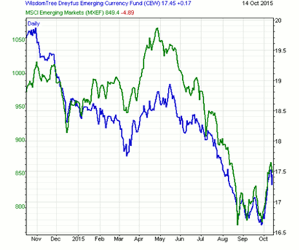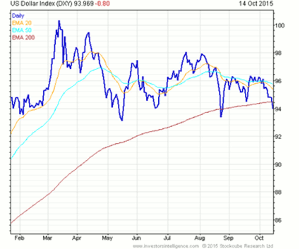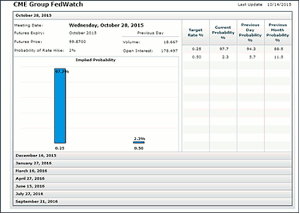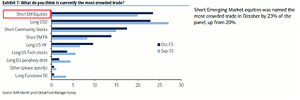The staff at Admiral Markets takes a technical look at the chart of the emerging markets and points out that in every currency trade there are two sides of the equation to consider. The staff goes one step further by also highlighting one of the key drivers of currency price formation.
For the last twelve months I have been pointing out the downside risk in emerging markets which have principally been driven by the strong US dollar and the weakness in global commodity prices, that this and slowing global demand have created. This has negatively affected the values of both currencies and equities across almost all of the developing world.
The chart below plots the MSCI Emerging Markets index (MSCI) and the Wisdom Tree EM currency ETF (CEW). Which together provide a handy overview / proxy of the performance of the asset classes for the EM group as a whole. As we can see the story over the majority of 2015—for both EM equities and currencies—has been a sharp sell-off, which itself was a continuation of trend that started back in the summer of 2014.
However, as we can see by looking at the far right hand side of the chart, there has been some interesting price action of late? Indeed one could argue that we may have formed or are in the process of forming a bottom. From which both equities and currencies have attempted to rally.
Whilst its early days, one of things that markets and those that commentate on them try to anticipate is the next trend or change in direction. Stock markets have historically been thought to look six months into the future. Which is why, for instance, forward guidance is often given greater weighting than historic figures (earnings) when companies report. FX markets—whilst obviously concerned with current events—are also anticipating future events and trends in their price formation process. Think here about the path of future interest rates or GDP growth as examples of this.
So, given the above and the fact that markets and economic trends move in cycles, is there a case to be made for emerging markets on the upside?
In every currency trade there are two sides of the equation to consider. Each time they enter a position, currency traders are backing one currency to outperform the other, regardless of the direction of the trade .So it follows that when looking at the bigger picture there are two sides of the story to consider. Therefore, without even looking at the EM currencies themselves, the first thing we need to consider is what's happening and is likely to happen to the US dollar. Which, as we have already noted, is one of the principal drivers of EM weakness and commodity prices.
The chart below plots the trade weighted US dollar or dollar index over the past nine months.
As we can see from the chart above, the idea that the dollar has been strong over the course of 2015 does not really hold water. Indeed, after we posted the highs of March and April at 100.39 and 99.68 respectively, we have sold off to close at 93.97 as of the 14th of October. Recent data from the USA has been on the weak side, the poor retails sales numbers posted on last Wednesday follow on from a miss on September non-farm payrolls. As well as significant misses in recent Empire State Manufacturing and Philly Fed survey data, both of which speak to the health of the US manufacturing and industrial economies .
(Both the Empire State and Philly Fed releases on Thursday, the 15th of October were negative, CPI data was mixed, though we should note that the weekly jobless number was more positive.)
Knock on Effects
The impact of this weak data combined with rising concern about a hard landing in China and the possible knock on effects of that meant that the Federal Reserve did not raise US Interest rates in September. Nor is it thought likely to do so at its October or December meetings.
Indeed two Federal Reserve Governors have spoken out last week (October 13, 2015) to say that under current conditions a rate rise does not look warranted.
NEXT PAGE: One of the Key Drivers of Currency Price Formation
|pagebreak|The graphic below shows the probability of an October rate rise as derived from the Fed Funds Futures at the Chicago Mercantile Exchange (or CME) as of the close of business on the 14th of October. Which, as we can see, was running at just 2.00% . I also note that, as of 10-14-15, there is only a 33% chance, according to this measure, of a rise on December 15 (or if you prefer, a 67% probability of no rate rise in 2015 at all) as the FOMC do not meet in November.
As I am sure most of us are aware, interest rates and their predicted future path are one of the key drivers of currency price formation. An expectation of higher interest rates in currency A overtime, versus that expected in Currency B, should mean that currency A strengthens against currency B. However, if the expectation of higher interest rates in currency A diminishes, then the reverse is likely to be true.
Supply and Demand
This thought process sets up an interesting scenario, which—as with many things in trading and the markets—can be distilled down to supply and demand.
The thinking goes like this:
Short EM equities, long the US dollar, short commodity related stocks, and short EM FX have been profitable and popular or if you prefer crowded trades for much of the last 12 months. That is to say there have been plenty sellers, and therefore, plenty supply of emerging market equities, currencies, and commodity-related stocks.
For many of those trades, there will also have been a corresponding purchase of US dollars or if you prefer demand for dollars. As we know and have seen regularly this year, liquidity in the modern markets can be fleeting, particularly around inflection points or a change in thinking or outlook.
Let us consider the following scenario:
The chart above comes from the authoritative Bank of America Merrill Lynch Fund Managers Survey, which polls more than 200 money managers who manage more than $500 bln. In this case, the October survey asks them what they consider to be the most crowed trades currently in the market place. We can see a familiar looking list above.
Given what we know about the asymmetrical nature of liquidity in modern markets, it is interesting to speculate what might happen if we see a continued stream of weak US data that further weakens the dollar and pushes back the likelihood of an early rate raise.
One Possible Outcome
One possible outcome is as follows:
As poor economic data weakens the dollar and expectations of a rate rise fade. Money will likely to start to leave the dollar i.e. excess dollar supply, which could weaken the price further and in turn create more sellers or more supply.
At the same time, those managers and traders that put on their long dollar trades against shorts in EM currencies, equities, and commodity-related stocks will probably want to close these trades out.
Whilst liquidity issues are likely to be manageable on the US dollar side of the trade, within the emerging market and commodity legs, it could be a completely different story, however.
Consider the recent moves in the Malaysian Ringgit and the shares of one of the world's biggest mining and commodity trading groups Glencore, as examples of sharp sentiment driven moves in thin markets.
Remember also that a weaker dollar—or the wide spread perception of one—would also take some of the pressure off of commodity prices, which in turn, would be beneficial to EMs and commodity-related equities.
It's just a thought….
By the staff of Admiral Markets

























